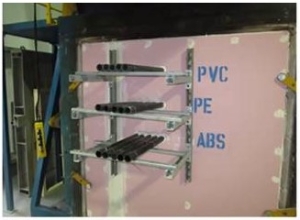Should plastic/ combustible pipes with a diameter of below 40mm be firestopped? Firestopping FAQs
There is a long-standing myth in the construction industry that pipes with an internal diameter of 40mm or less do not need to be firestopped where they penetrate compartment walls and floors.
However, with years of fire testing experience, we know that additional service penetration sealing elements are required to maintain the fire rating of walls and floors when testing to current test standards – no matter how small the penetrating service is.
Therefore, a suitable firestopping solution should be installed in addition to sealing a pipe.
Approved Document B (England & Wales)
Section 9 of Approved Document B (England & Wales), vol. 1 for dwellinghouses, requires plastic/ combustible pipes of 40mm internal diameter [table 9.1, p.71] or less to meet the provisions in alternatives A, B or C:
- Alternative A:
Provide a proprietary, tested sealing system that will maintain the fire resistance of the wall, floor or cavity barrier.
- Alternative B:
Where a proprietary sealing system is not used, fire-stop around the pipe, keeping the opening for the pipe as small as possible.
- Alternative C (applicable to uPVC):
A pipe with a maximum nominal internal diameter of 160mm may be used with a sleeve made out of a high melting point metal.
Similar to Approved Document B’s section 9 is Scotland’s Technical Handbook, section 2.2.9.
Although the guidance in both of these documents could be interpreted that small plastic pipes do not specifically require the use of proprietary firestopping systems (Alternative A), it is important to note that this is still a grey area and is only a guidance note.
What the guidance doesn’t declare is how many holes you can have next to each other in a wall or floor. For example, if there are multiple 40mm holes all sealed using acrylic sealant, when exposed to fire the most the sealant will do is form a low-reaction char, unable to quickly close the gap left behind by the melting plastic/ combustible pipe. This would mean that there is every chance of fire spreading from one compartment to the next.
Fire testing to BS EN 1366 ensures that all firestopping products are capable of rapidly expanding to ensure quick closure of the pipe.
In the context of a sealed 40mm plastic/ combustible pipe (Alternative B), this will most likely result in two integrity failures: continuous flaming and a 25mm gap gauge failure. In the event of a fire, additional firestopping (e.g., a fire collar) would ensure that the hole is closed simultaneously to the pipe melting. Without additional firestopping, the plastic/ combustible pipe will just burn and consequently, flames will penetrate the compartment wall or floor – known as continuous flaming.
A gap gauge failure is the result of a gap of more than 25mm diameter formed by slumping or burning through of the pipe. Inevitably, if the pipe does not have additional firestopping, when it burns and melts it will leave behind a 40mm hole. Both continuous flaming and gap gauge failure result in a failed fire test specimen.
Furthermore, the guidance doesn’t clarify what plastic material types are covered. A fire test conducted by the ASFP, exemplifying Alternative B in a double-skin plasterboard wall, showed that different plastic materials react differently in a fire scenario.
They tested three types of plastic pipes where failure times for integrity were proven to be significantly lower than the usual 60/90/120 minutes:
- PE pipes: 17 minutes
- ABS pipes: 42 minutes
- PVC pipes: 42 minutes
This emphasises that Alternative B is not fit or safe for purpose.

The fire-resistance requirement itself is overlooked. It is likely that for service penetrations the requirement will be for both integrity and insulation. The only provable way of having an insulation fire-resistance rating is using a tested system as per Alternative A.
Therefore, Alternative A represents the most suitable solution as manufacturers, like ourselves, have test evidence for applications like this, including extensive technical support and a field of application which can clearly be understood by the installer.
It is important to note that the guidance in Approved Document B and Scotland’s Technical Handbook are only used to help meet building regulations. However, following this guidance does not guarantee the building work complies with the requirements of regulations. The only way to ensure you have complied is by using products in applications with specific fire test evidence.
For advice on which tested service penetration seal to use on your application, please get in touch at technical@quelfire.co.uk.

